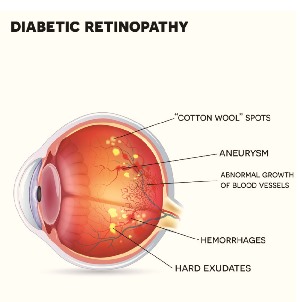Diabetic Eye Disease

Diabetes is a major cause of preventable blindness in the South Asian population. It is important for every diabetic patient to have an eye exam at least once a year with an ophthalmologist to evaluate for diabetic retinopathy, macular edema, and cataract formation.
The retina is the part of the eye that senses light and relays this information to the brain. Diabetic changes in retinal blood vessels impair the vessels’ ability to supply vital nutrients and oxygen, leading to ischemia and oxygen deprivation. As a result, these poorly oxygenated areas trigger the formation of new blood vessels to provide an alternate path for oxygen and nutrients. These new vessels, however, are abnormal and grow along the surface of the retina in a membrane that may contract, causing the blood vessels to tear and bleed into the eye. This can lead to a further deterioration of vision as the blood accumulates in the gel-type material of the eye, the vitreous, causing a vitreous hemorrhage. Furthermore, this can lead to a fibrous reaction in the eye that can cause a detachment of the retina and vision loss.
normal300.jpg)
In addition to the formation of new vessels, diabetes can cause existing blood vessels to become leaky. The fluid that leaks from these vessels may lead to swelling in the central visual area, causing macular edema. Macular edema is a common cause of central vision loss in diabetic patients, which when detected early can be treated in various manners, including laser treatment.
Finally, due to elevated blood sugar levels, diabetics are also more likely to develop cataracts or clouding of the natural lens. Cataracts can lead to blurry vision, difficulty reading, difficulty with bright lights and glare, and difficulty driving at night.
As there are many grave and severe consequences of diabetes, it is important to note that the early stages of diabetic retinopathy may go unnoticed and may not present with vision loss. It is very important for every diabetic patient to have routine eye screenings with an ophthalmologist to detect early diabetic changes in the eye and prevent permanent vision loss and blindness.
Dr. Shalin Shah, MD is a general ophthalmologist and glaucoma specialist with a focus on cataract surgery and diabetic eye care. He completed his residency and fellowship at LSU/Ochsner in New Orleans, LA.
[Gulshan Harjee, M.D., is a board certified internist in private practice with an emphasis on prevention. Please email your health and medical questions for consideration in this column to: gharjee@comcast. net. The material in this column is of a general nature, and must not be construed as specific medical advice. This column rotates monthly along with the Fitness Lifestyle column by Aarti Patel.]
Enjoyed reading Khabar magazine? Subscribe to Khabar and get a full digital copy of this Indian-American community magazine.
blog comments powered by Disqus










